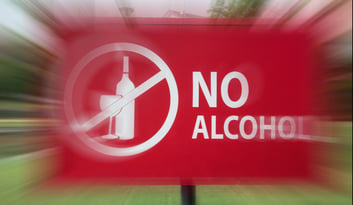Share this
Toxicologists Use Microsampling to Quantify Alcohol Abuse Biomarker
by Neoteryx Microsampling on October 20,2020
October 2020 — Alcohol-related death statistics around the world are staggering. Numbers from the World Health Organization (WHO) reveal that each year, approximately three million people around the globe die as a result of alcohol abuse. That is roughly one in 20 alcohol-related deaths worldwide.
 Statistics from the National Institute on Alcohol Abuse and Alcoholism (NIAAA) in the United States reveal that there are approximately 88,000 alcohol-related deaths in the US each year. Out of that number, nearly 10,000 US deaths are related to alcohol-impaired driving. Other statistics reveal that alcohol use disorder (AUD) also negatively impacts a person's health, career, and the welfare of their family.
Statistics from the National Institute on Alcohol Abuse and Alcoholism (NIAAA) in the United States reveal that there are approximately 88,000 alcohol-related deaths in the US each year. Out of that number, nearly 10,000 US deaths are related to alcohol-impaired driving. Other statistics reveal that alcohol use disorder (AUD) also negatively impacts a person's health, career, and the welfare of their family.
To help address this global health concern, research scientists are investigating ways to help the medical, governmental and law enforcement communities improve alcohol prevention and intervention programs by identifying methods for detecting and quantifying alcohol use and abuse.
The toxicology research team at the Ghent University's Laboratory of Toxicology has provided access to a peer-reviewed article-in-press for the journal Talanta, describing their study of phosphatidylethanol (PEth) as a direct marker of alcohol intake. The Ghent researchers worked with the laboratory research team at the National Institute of Criminalistics and Criminology (NICC) to develop a quantitative method for analyzing PEth in specimen samples as a biomarker of alcohol intake.
For their collaborative PEth study, the research teams in both labs used remote specimen collection as a quick and easy way to gather samples from subjects out in the field, without the need for onsite assistance from healthcare personnel. It is hoped that the collaborative efforts of both labs will lead to a repeatable method for quantifying PEth that can be used by a larger network of labs across Belgium, Europe, and beyond.
Remote Sample Collection and Volumetric Absorptive Microsampling in the Lab
 Dried blood microsamples were collected from study subjects using Mitra® devices from Neoteryx. The Mitra device is based on VAMS® technology, which allows virtually anyone to collect a fixed-volume specimen that is suitable for lab analysis.
Dried blood microsamples were collected from study subjects using Mitra® devices from Neoteryx. The Mitra device is based on VAMS® technology, which allows virtually anyone to collect a fixed-volume specimen that is suitable for lab analysis.
The researchers report that once the microsamples arrived in the lab, PEth 16:0/18:1 was quantified after liquid-liquid extraction using two independent isotope dilution – liquid chromatography – tandem mass spectrometry methods.
Investigators at both sites performed a systematic review of the entire process before the final method comparison. For their study, they used samples from 59 routine toxicology cases collected within a one-year time interval.
Performing Method Validation to Arrive at Promising Results
The two labs solved any initial differences between their methods by concentrating on important methodological aspects: trueness verification of the calibration protocol focusing on the primary material, preparation of the stock solutions, and adequate equilibration of calibrators and QCs. They also focused on verifying comparability of their results, which were obtained with different m/z transitions.
Several of these aspects could only be verified by critically assessing spiked and native samples. After a final validation, they observed good average comparability of the two methods. They report that the average bias was -0.4%, with 85% of the differences within 20%. Moreover, the methods proved to be reproducible and robust within a one-year time interval.
According to the paper, co-authored by Drs. Katleen Van Uytfanghe, Maria del Mar Ramirez Fernandez, Aurelie De Vos, Sarah MR Wille, and Christophe Stove, this study is the first to develop a quantitative volumetric absorptive microsampling method for PEth measurements. Additionally, it is the first study to perform a systematic comparison of PEth measurements between two laboratories.
Learn more about microsampling in toxicology studies by visiting our Toxicology Resources page.

Share this
- Microsampling (39)
- Industry News, Microsampling News (33)
- Mitra® Device (31)
- Company Press Release, Product Press Release (21)
- Research, Remote Research (17)
- Infectious Disease, Vaccines, COVID-19 (15)
- Clinical Trials, Clinical Research (13)
- Blood Microsampling, Serology (10)
- Biomonitoring, Health, Wellness (8)
- Decentralized Clinical Trial (DCT) (8)
- Omics, Multi-Omics (6)
- Venipuncture Alternative (6)
- Specimen Collection (3)
- Toxicology, Doping, Drug/Alcohol Monitoring, PEth (3)
- Harpera® Tool (2)
- Pharmaceuticals, Drug Development (2)
- Skin Microsampling, Microbiopsy (2)
- Therapeutic Drug Monitoring, TDM (2)
- Antibodies, MAbs (1)
- Environmental Toxins, Exposures (1)
- Preclinical Research, Animal Studies (1)
- hemaPEN® Device (1)
- January 2024 (1)
- December 2023 (2)
- November 2023 (3)
- October 2023 (2)
- September 2023 (1)
- August 2023 (3)
- July 2023 (3)
- June 2023 (1)
- May 2023 (2)
- April 2023 (1)
- March 2023 (2)
- February 2023 (1)
- January 2023 (2)
- December 2022 (1)
- November 2022 (1)
- October 2022 (2)
- September 2022 (1)
- August 2022 (1)
- April 2022 (1)
- February 2022 (1)
- January 2022 (1)
- December 2021 (1)
- November 2021 (1)
- October 2021 (2)
- September 2021 (1)
- August 2021 (2)
- July 2021 (2)
- June 2021 (2)
- April 2021 (1)
- March 2021 (2)
- February 2021 (1)
- January 2021 (1)
- December 2020 (1)
- November 2020 (1)
- October 2020 (1)
- September 2020 (2)
- August 2020 (3)
- July 2020 (3)
- June 2020 (2)
- May 2020 (1)
- April 2020 (3)
- October 2019 (1)
- March 2019 (1)
- January 2019 (1)
- November 2018 (1)
- August 2018 (1)
- July 2018 (1)
- June 2017 (1)
- April 2017 (1)
- March 2017 (1)
- February 2017 (1)
- May 2016 (1)
- December 2015 (1)
- October 2015 (1)
- August 2015 (1)
- August 2014 (1)
- July 2014 (1)


Comments (1)